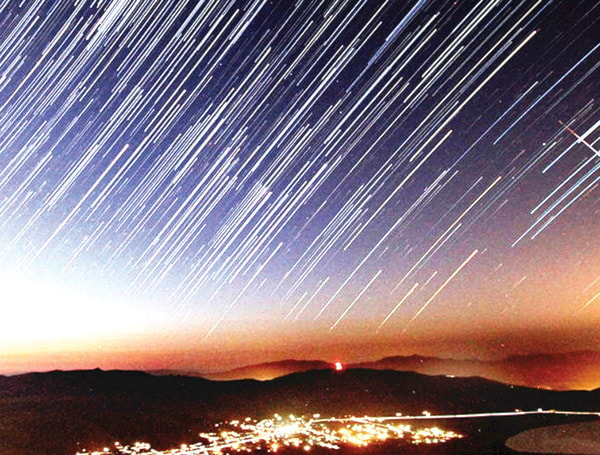The much-anticipated Perseid meteor shower is being billed as one the best galactic light shows in years.
Experts are predicting at the height of the storm from Thursday to Saturday, as the earth passes through the debris-ridden orbit of the Swift-Tuttle comet as many as 200 “shooting stars” an hour may be visible as they brightly burn up in the atmosphere.
An added bonus this year is an earlier setting of the moon resulting in a darker sky making it much better to see the show.
Depending on the forecaster, weather conditions for the evening range from clear to partly cloudy.
One of the best locations to watch the stars come out, complete with enlightening commentary from research scientists, is the Dominion Radio Astrophysical Observatory in White Lake on Saturday.
from research scientists, is the Dominion Radio Astrophysical Observatory in White Lake on Saturday.
One of those astronomers will be Ken Tapping.
“What was originally some totally invisible black lump of dirty ice leaves this great big wonderful trail millions of kilometres long lit up by the sun and that’s what we call a comet,” said Tapping, who also writes the Stargazing column for the Western News and other publications.
“It’s disintegrating stream of this debris moving at about 60 kilometres a second and we go right through it at 30 km/second every August.”
He added peoples’ fascination with the streaking lights shooting across the night sky is as old as life itself.
“From the cultural view I think anything happening in the heavens, and I deliberately use that word because when our ancestors were staring up into the sky noticed that things were very different up there from down here, people have always marvelled at that,” said Tapping. “Down here everything’s very unpredictable and very dangerous and up there hardly anything ever changes, everything just has its regular rhythm and so when something comes and breaks the rhythm it really, really changes things and people are usually scared.
“Comets were always seen as harbingers of disaster.
Meteor showers were always watched with great admiration and of course, I dare say, our various sooth sayers pronounced various things on the basis of seeing them.”
And as long as he has worked in the business Tapping has never lost his enjoyment of staring out into space.
“This is actually one of the things I really love about astronomy that you can enjoy lying on your back on the ground by a lake or in a forest looking up at a really dark sky and you can take it all the way through to casual or detailed measurements or sitting at your desk trying to figure out how black hole works and I think this is so wonderful,” he said.
Veteran astronomer Chris Purton also enjoys the reaction of those attending the meteor showers at DRAO.
I’ve seen as many as 1,000 people out there and they’ve brought their lawn chairs and their blankets and their families,” he said. “It’s very, very quiet. You just sort of hear a murmur in the background and a bright meteor will go across and the whole outfit just goes Oooooooooh.”
Gates at the observatory open at 7:15 p.m. and following presentations by Tapping and the other scientists, Tim Robishaw, Ryan Ransom, Tom Landecker and Roland Kothes, things will move outdoors.
On the quirky side of the shower, Tapping will demonstrate how the meteor trails actually act as a radio station repeater as the FM signals bounce back to earth.
He even has a preset station on his car radio for just that reason.
“When a meteor comes into the atmosphere it burns up and creates such high temperatures that the air atoms actually ionize, they break up and essentially become like a long rod of copper in the sky until it dissipates and then you have an FM station,” he explained. “In this case it’s Sunny 102.3 FM Modesto, Cal. So when CBC gets boring I listen to meteors and once I got 30 seconds of Shania Twain, the signal so strong I thought this can’t be a meteor signal, then it faded away like nothing ever happened.”
He added the concept was used by the military prior to communication satellites.
One of the topics Tapping will touch on is the continuing construction of the Earth through build up of comet debris.
“The stuff we are ploughing through over the next few days is all very fine grit and these things are going to burn up and then become microscopic dust that floats down to earth’s surface so we sweep up a little bit of this material and our planet gets bigger,” he said. “From a scientific view these little bits of grit are the primary construction material the solar system is made from.”
Tapping doesn’t discount the possibility our planet could one day be hit by a large astroid but doesn’t expect it to be this weekend.
“But the trouble is once you do find something a couple of kilometres and size coming at you, what do you do?
The theatrical thing of seeing this great big thing coming at the earth and you’re going to blow it to bits is really not going to do a lot of good because in that sense I would rather the earth got hit by a rifle bullet than a shotgun blast.
“However it just goes to show the universe is a somewhat scary place but then on plus side, life appeared on the earth about three and a half million years ago and we’re still here and so far the biggest threat to our existence seems to be us.”
The observatory is located at 717 White Lake Rd. Admission is free and those attending are asked to bring a blanket or lawn chair.
Telescopes for other viewing opportunities during the evening will be provided by the Okanagan Centre of the Royal Astronomical Society of Canada.
